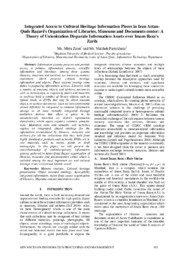Integrated Access to Cultural Heritage Information Pieces in Iran Astan- Quds Razavi's Organization of Libraries, Museums and Documents center: a Theory of Unionization Disparate Information Assets over Imam Reza's Zarih
Abstract
Information systems preserve and provide
access to primary information sources, scientific
information and literature. Among these systems
libraries, museums and archives are known as memory
institutions, which preserve cultural heritage
information and objects. These systems overlap some
duties in preparing information sources. Libraries hold
a number of museums objects and archives documents
such as manuscripts or engraving plates and museums
or archives hold a number of library objects such as
typical books or DVDs that may be about museum
objects or archive documents. Such an interrelationship
should definitely be integrated in common information
storage or at least virtually integrated through
mediation devices that allow a query to be
simultaneously launched on distinct information
depositories which again requires common semantic
tools. Mediation tools and semantic web activities
require an integrated, shared ontology for the
information accumulated by libraries, museums and
archives for all the collections that they hold from
highly standardize products such as books, DVDs, etc to
raw materials such as stones, plants or draft
manuscripts. In this paper, we will present the
interrelationship of multidisciplinary information
sources gathered in Astan Quds Razavi organization of
libraries, museums and documentation center which is
included among the most important art and cultural
heritage center in Iran and Islamic world.
